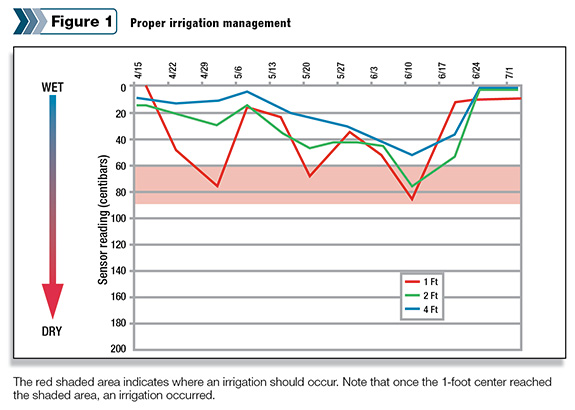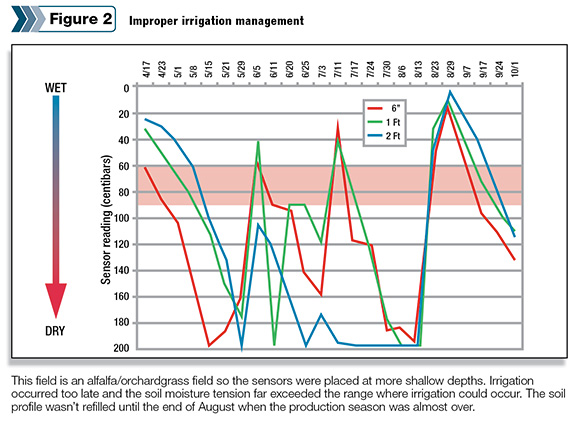The truth is, the end of the season is a good time to reflect back, think about what should be changed and prepare to make necessary improvements.
Irrigation management is a good place to start, as I believe yields in the West are limited more often and to a greater degree by improper irrigation management than any other single factor.
Improper water management often goes undetected because unless it is severe, the consequences of under irrigation or over irrigation can be subtle, and the grower cannot visually observe the effect on yield.
Proper irrigation management boils down to two simple questions: “When should I irrigate?” and “How much water should I apply?”
Unfortunately, answering these questions is not such a simple task. Monitoring actual crop water use or evapotranspiration (ET), which is calculated using weather instruments, is one way to schedule irrigation of forage crops.
However, even though this method is relatively accurate, it can be difficult to use in forage crops for several reasons.
• Keeping track of ET data for different fields, which can be a time-consuming task
• Inability in some cases to find a representative weather station
• Difficulty in scheduling irrigations around cuttings
• Complicated-to-use ET data to schedule irrigations when entire fields are not irrigated at once (usually the case with sprinkler irrigation where fields are irrigated in sets)
An effective way to use weather-based scheduling is to use historical ET values to make sure your irrigation application rates are close to what is needed to match ET values and then use soil moisture monitoring to fine-tune irrigation practices.
Soil-based irrigation scheduling
Soil-based measurements may be a far more practical and easy method for forage producers to use to schedule irrigations and assess the adequacy of current irrigation practices.
Soil moisture content can be monitored by using a soil auger and the “feel” method or with soil moisture sensors.
Several types of soil moisture monitoring equipment are available, but resistance blocks are perhaps the most common because they are one of the least expensive, are easy to use and are reasonably accurate.
The numeric soil moisture value obtained may vary with different devices, so the actual reading may not be as critical as watching the trends over time and learning what the values mean for your specific soil type.
The soil moisture sensor we primarily use estimates soil moisture tension in centibars. The soil moisture tension refers to how strongly water is held onto soil particles.
The higher the tension, the more difficult it is for plant roots to extract water. Simply put, low soil moisture tensions indicate moist soil, and high soil moisture tensions indicate dry soil.
Understanding the resistance block readings
When the soil is saturated after a rainfall or irrigation (air spaces are mostly filled with water), the reading is low, typically less than 10.
Then with evaporation from the soil surface and transpiration by the alfalfa plant, the soil dries and the moisture sensor readings gradually increase. Eventually, the soil dries enough that an irrigation is necessary.
The centibar reading at which irrigation is needed is somewhat dependent on soil type. A general recommendation is to irrigate sandy soils when the upper sensor reads 40 to 70 centibars. For sandy loam or loam soils, irrigate when the readings reach 60 to 90 centibars.
Soil moisture sensors may not be useful for very sandy soils with inherently low water-holding capacity, as the sensors may not respond quickly enough to the rapid decline in soil moisture.
After the field is re-irrigated, the centibar readings typically drop into the teens or single digits. Sometimes the sensor readings at the lower depths do not change after an irrigation.
This is an indication that the amount of water applied was insufficient to reach the sensor depth.
The key to proper irrigation management using soil moisture sensors is to irrigate when the centibar readings are in the desired range for your soil type.
Irrigating when soil moisture readings are beyond the desired range may result in crop stress and yield loss, while irrigation before readings reach the desired range may result in excessive irrigation. Yield can even be reduced if over irrigation is excessive.
Interpreting a soil moisture graph
The easiest way to interpret soil moisture readings is to plot the values on a graph because it shows a visual representation of how fast the soil is drying and shows trends over the season. An Excel spreadsheet to graph the data is available by contacting the author.
Figure 1 shows effective irrigation management and illustrates how readings typically fluctuate from spring through the first alfalfa cutting.
At the start of the season, the soil is moist from winter and spring rains and the readings are less than 20 centibars.
Gradually the soil dries after winter and spring rains, and the readings increase, starting with the sensor located at the 1-foot depth followed by the deeper depths.
The uppermost sensor reading normally climbs first, as there is greater root activity in the upper portion of the soil profile than at deeper depths.
When the soil moisture content dropped to near 80 in early May, an irrigation was applied and the centibar readings at all three depths went to below 20, indicating the soil profile had been refilled.
The drying cycle resumes until a partial irrigation occurred in early June. The reason for the partial irrigation was that it was needed to replenish enough soil moisture to carry the crop through the cutting process without excessive soil moisture depletion and crop stress.
The first cutting occurred in early June (note point on graph when soil moisture content was lowest). Following cutting irrigations resumed until the soil moisture content of all three depths was restored (all readings below 20 centibars).

Figure 2 is an example of severe under-irrigation. Irrigation started way too late and the soil was too dry for most of the season (very high soil moisture tension readings).
Sensor placement
We are relying on these readings to represent the entire field, so proper sensor placement is absolutely critical.
Sensors must be installed in an area where the soil type is typical of the field and receives full sprinkler irrigation coverage, or the readings can be misleading.
It is best to have two evaluation sites per field so they can be compared with at least two or three sensors per evaluation site. Install one sensor in the upper one-quarter of the root zone of the crop. The other should be placed toward the bottom of the root zone.
If three sensors are used, install them at 1 foot, 2 feet, and 3 or 4 feet (depending on the depth of the soil). The upper two sensors are used to determine when to irrigate. A detailed explanation of the sensor installation procedure can be found in literature from the manufacturers.
Value of soil moisture monitoring
Soil moisture readings are particularly valuable to:
• Αssess whether winter rains completely refilled the soil profile
• Determine when to begin irrigating in spring rather than guessing
• Decide whether another irrigation is needed before cutting
• Ascertain whether the last irrigation was adequate to refill the soil profile
• Assess the deep-moisture status
• Evaluate current irrigation practices
The most common irrigation errors that can be corrected are too late an irrigation starting date, under irrigation in mid-summer and over irrigation in fall. Relatively minor adjustments in irrigation practices can pay large dividends in increased yield or water savings. FG










